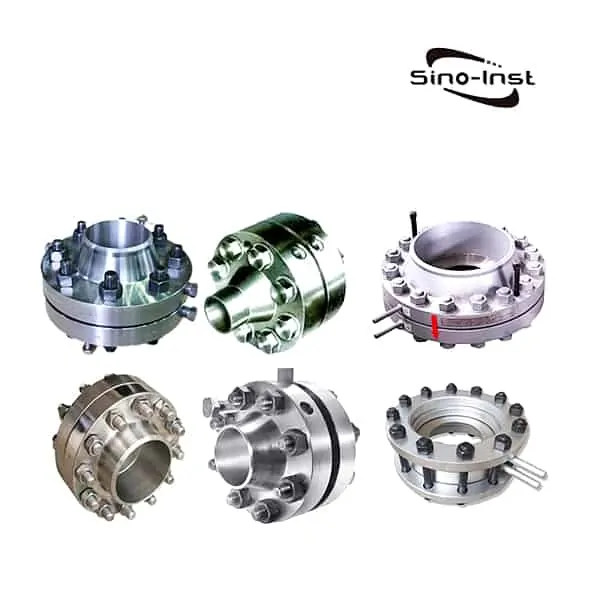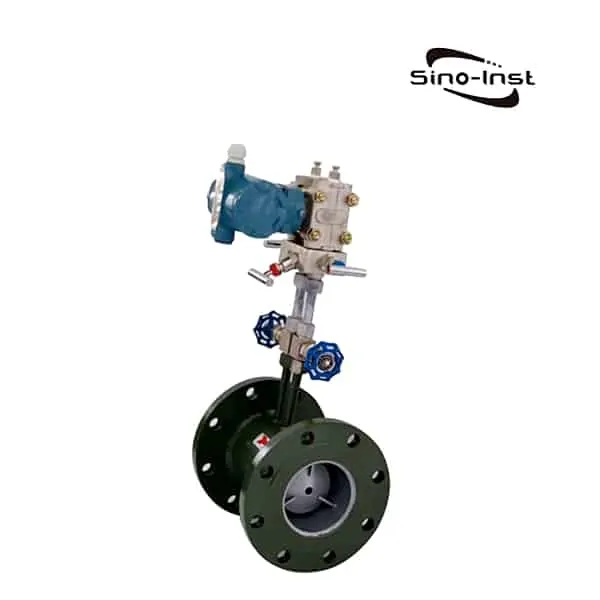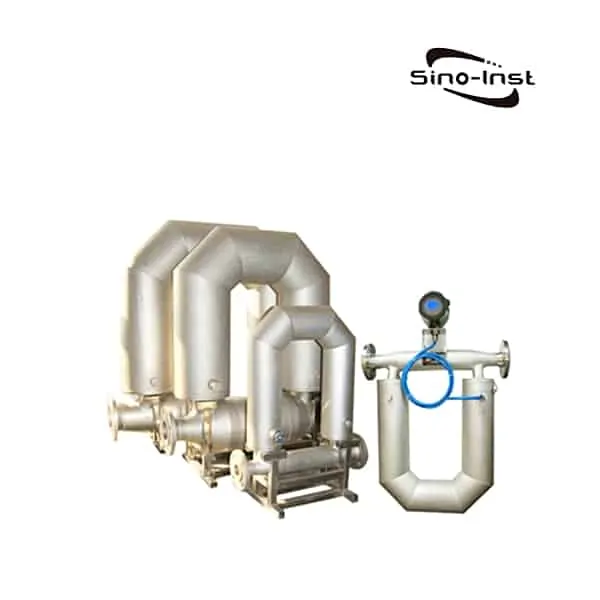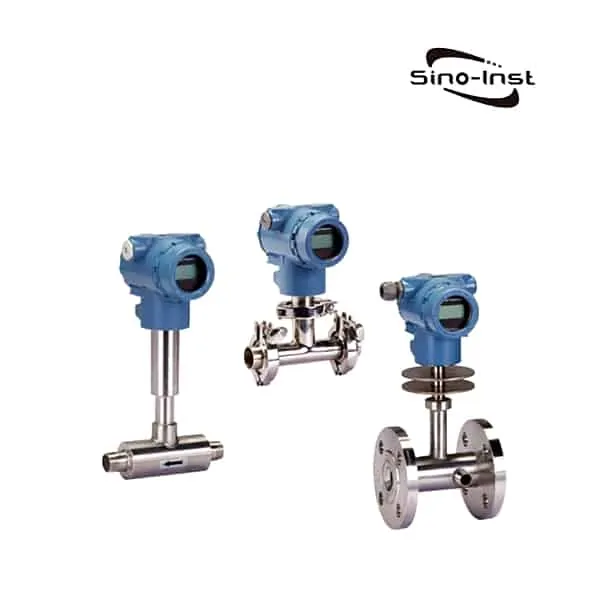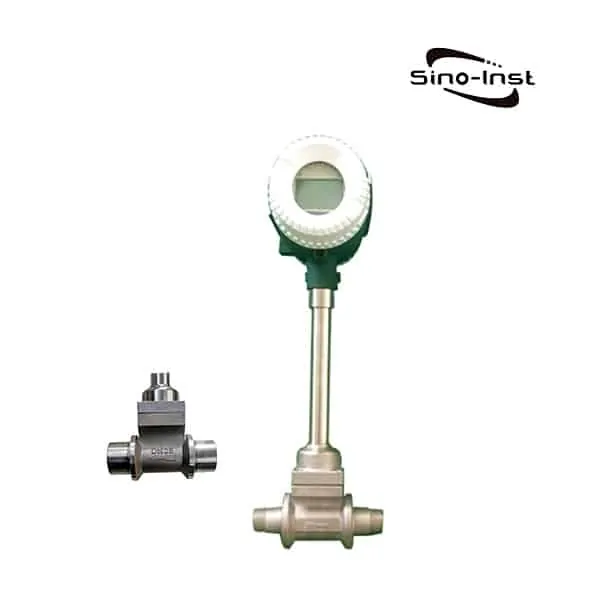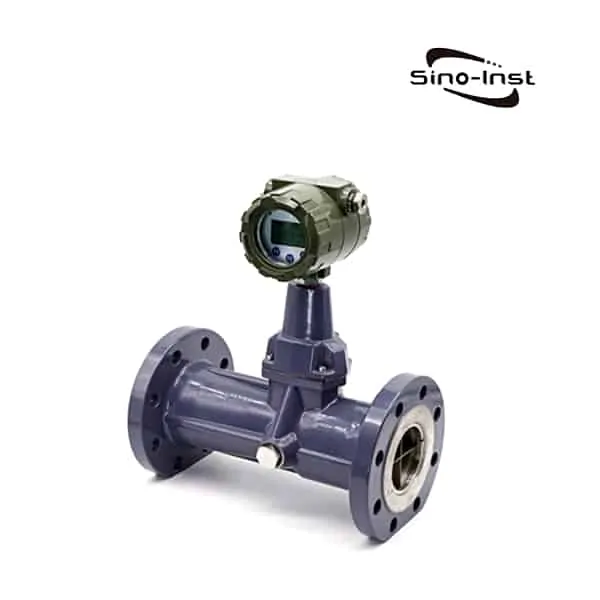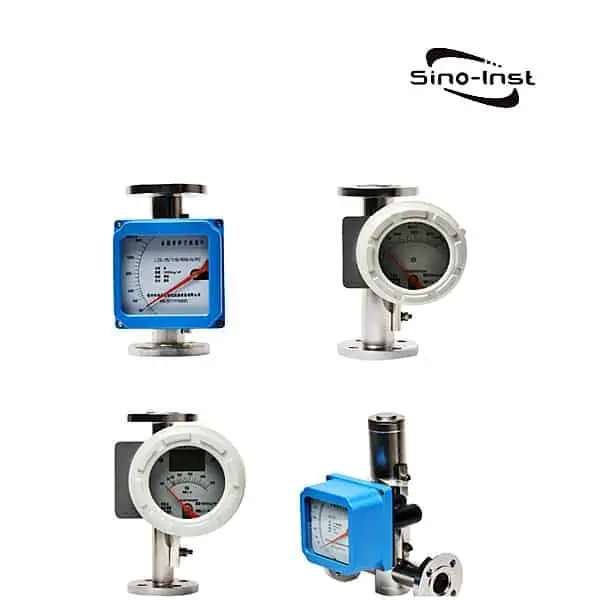A liquid nitrogen flow meter is a commonly used cryogenic flow meter. The low-temperature turbine flowmeter is a dedicated liquid nitrogen flowmeter. It can also be used to measure cryogenic liquids such as liquid oxygen.
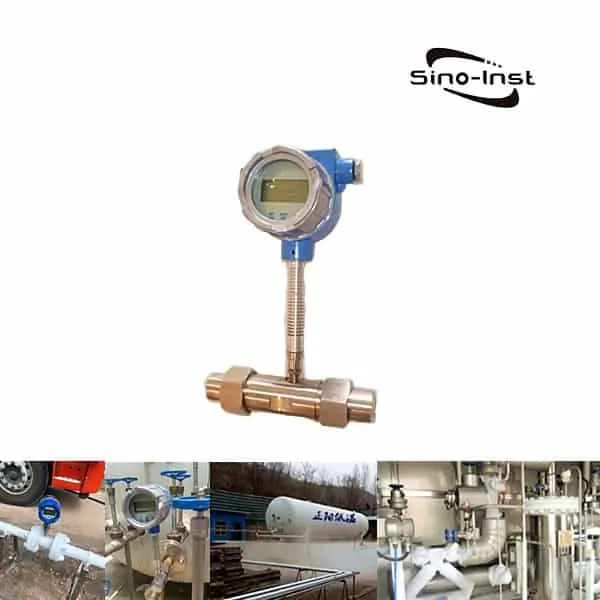
Liquid nitrogen refers to Liquid with extremely low temperatures. In industrial production, liquid nitrogen can be used as a deep refrigerant. The low-temperature turbine flowmeter is used as a liquid nitrogen flowmeter, which can work at a low temperature of -196°C (-320.8 °F). Liquid Nitrogen Flow Meter’s Turbine sensor structure at ultra-low temperature (-196℃) is made of special customized material. Realize the instantaneous and cumulative flow monitoring of liquid nitrogen.
Sino-Inst offers a variety of Turbine flow meters for flow measurement. If you have any questions, please contact our sales engineers.
Features of Turbine type Liquid Nitrogen Flow Meter
- The sensor is a fully enclosed structure, so it is safe and reliable, and can be used for high-pressure pipeline measurement according to requirements;
- The sensor material can be customized according to requirements, such as 304, 316 and all tetrafluoroethylene materials, suitable for various media, such as acid, alkali and other strong corrosive liquids;
- The sensor is a hard alloy bearing thrust type, which not only ensures accuracy, but also improves wear resistance.
- The sensor has been specially modified by our company, the structure is simple, firm and easy to disassemble;
- Wide measuring range and low lower limit flow rate;
- Measurement accuracy 0.2, 0.5, 1.0 can be selected as required;
- Our company’s caliber breaks through the convention, from 0.5mm, 1mm, 2mm, etc. to super large diameter insert type can be customized;
- When the anticorrosive PTFE material is constructed, the PTFE materials are all imported from Japan, which is safe and reliable;
- Ultra-high pressure type sensor adopts high thickness sealed sensor, matching high pressure flange or installation accessories;
- At ultra-low temperature (-196℃), the sensor structure is made of special custom-made imported materials, supporting low temperature resistant amplifier;
- The comprehensive pressure loss is small, the repeatability is good, and the accuracy is high.
- It has high resistance to electromagnetic interference and vibration.
- Various displays, battery-powered on-site display, external power supply display, and various signal outputs are all configured;
- The supporting explosion-proof meter is suitable for the use of explosion-proof products;
- Various installation methods are available: thread, flange, quick installation, direct welding, etc.;
- It can be used with flow totalizer to complete remote display;
- It can be combined with control instruments and control systems to form automatic quantitative conveying and feeding equipment;
Know more about: Turbine type Flow Meter
Specifications of Turbine type Liquid Nitrogen Flow Meter
- Nominal diameter:
Common type (0.5~300) mm;
Anti-corrosion type (6~100) mm
Insertion type (80~600)mm - Medium temperature:
Ordinary type (-20~80)℃
High temperature type (-20~120)℃
Ultra-low temperature type (-196~80)℃ - Ambient temperature: (-20~55)℃;
- Accuracy: ±0.2%, ±0.5%, ±1%;
- Detector signal transmission line system: three-wire voltage pulse (three-core shielded cable);
- Power supply: voltage: 12V±0.144V, current: ≤10mA;
- Output voltage amplitude: high level ≥ 8V, low level ≤ 0.8V;
- Transmission distance: The distance between the sensor and the indicator can reach 250 meters;
- On-site display power supply: 3V (powered by lithium battery, can be used continuously for 3 years);
- Display mode: on-site LCD display instantaneous flow and accumulated flow;
- On-site display power supply with signal output: 24V; 4-20mA two-wire current output, remote transmission distance of 500 meters.
Extended reading: Turbine Flow meter Vs Gear Flow meter
The flow range and pressure are shown in the figure, and the flow unit is m3/h (for anti-corrosion or plug-in type, please inquire)
|
Dn (mm) |
Flow Range |
Nominal pressure PN (Mpa) |
Maximum pressure loss(Mpa) | |||||
|
Basic error limit ±0.2% |
Basic error limit 0.50% |
Basic error limit 1.00% |
||||||
| Lower limit | Upper limit | Lower limit | Upper limit | Lower limit | Upper limit | |||
| 0.5 | 0.004 | 0.012 | 1.6 or 4 | 0.15 | ||||
| 1 | 0.007 | 0.021 | ||||||
| 2* | – | – | – | – | 0.01 | 0.13 | ||
| 3* | – | – | – | – | 0.04 | 0.25 | 0.12 | |
| 4* | – | – | – | – | 0.04 | 0.25 |
4 6.3 16* 25* 35*(Note 1) |
|
| 6 | 0.1 | 0.6 | 0.1 | 0.6 | 0.08 | |||
| 10 | 0.25 | 1.2 | 0.2 | 1.2 | ||||
| 12 | 0.8 | 2.5 | 0.4 | 2.5 | 0.25 | 2.5 | ||
| 15 | 1.2 | 4 | 0.6 | 4 | 0.4 | 4 | ||
| 20 | 1.5 | 7 | 1.1 | 7 | 0.7 | 7 | ||
| 25 | 2 | 10 | 1.6 | 10 | 1 | 10 | 0.04 | |
| 32 | 3.2 | 16 | 2.5 | 16 | 1.6 | 16 | ||
| 40 | 4 | 20 | 3 | 20 | 2.5 | 25 | 4 or 10 | |
| 50 | 8 | 40 | 4 | 40 | 4 | 40 | ||
| 65 | 12 | 60 | 6 | 60 | 6 | 60 | 1.6 or 2.5 | |
| 80 | 20 | 100 | 10 | 100 | 10 | 100 | ||
| 100 | 25 | 160 | 20 | 160 | 16 | 160 | ||
| 150 | 50 | 300 | 40 | 300 | 40 | 400 | ||
| 200 | 120 | 600 | 100 | 600 | 80 | 800 | 1.6 or 2.5 or 4 | |
| 250* | 200 | 1000 | 160 | 1000 | 120 | 1200 | ||
| 300* | 250 | 1600 | 180 | 1800 | ||||
Note 1: There is no 35MPa for diameter 32mm
Note 2: “*” is a special order.
The nominal diameter is 0.5mm, the flow range is 0.02~0.06 m³/h, the basic error: ±1% of reading, when ≤0.02 m³/h, the basic error: ±1%FS. The flow range with a nominal diameter of 1mm is 0.03~0.100 m³/h, the basic error: ±1% of reading, when ≤0.03 m³/h, the basic error: ±1%FS.
When the nominal diameter is 2mm and the flow range is 0.040~0.13m3/h, the basic error: ±1% of reading; when ≤0.040m3/h, the basic error: ±1%FS (full-scale value).
When the nominal diameter is 3mm and the flow range is 0.085~0.250m3/h, the basic error: ±1% of reading; ≤0.085m3/h basic error: ±1%FS (full-scale value).
The flow range shown in the table is a conventional value. If necessary, it can be appropriately extended according to user requirements. The minimum flow rate can be extended to about 0.3m/s, and some specifications can be lower. The accuracy in the extended area is based on the full-scale value. The relative error is expressed.
- Measuring medium: liquid (avoid multiphase flow)
- Medium viscosity range: ≤5mPɑ·S
- Calibration: Calibration with water before leaving the factory
Extended reading: Cryogenic Flow Meters | Liquid Nitrogen-Liquid Oxygen
Application of Liquid Nitrogen Flow Meter
- Quickly freeze and transport food, or make ice products;
- Conduct research on low temperature physics;
- In the electronics industry, dry nitrogen is used to purge silicon wafers to keep the silicon wafers dry and clean. In the large-scale integrated circuit production process, high-purity nitrogen can be used as the carrier gas, inert protective gas and packaging gas for chemical reaction gas.
- Liquid nitrogen is used for metal over-fitting or static-fitting assembly to avoid high temperature oxidation and maintain the surface finish of the parts. Parts soaked in liquid nitrogen can prolong the wear life after processing. Liquid nitrogen cooling during metal cutting has the advantages of long life and high surface finish.
- Nitrogen is mainly used as shielding gas and purge gas in metallurgical industry. In the process of steel rolling and metal heat treatment, due to the preservation of nitrogen, the high temperature oxidation of the metal is reduced and the surface is smooth and clean. Filling the non-ferrous metal smelting furnace with nitrogen can reduce oxygen content and temperature, reduce oxidation, and improve product purity. Purge the molten steel with nitrogen to reduce the hydrogen content in the steel and increase the strength of the product. When the blast furnace is started, 86% of nitrogen is blown in, which can reduce coke consumption and extend the service life.
- Used for chemical testing, such as BET specific surface area test method.
If you need to measure not liquefied nitrogen and liquefied oxygen, but gas nitrogen and oxygen. You can refer to:
Industrial oxygen flow meters Nitrogen flow measurement
Turbine type Liquid Nitrogen Flow Meter installation guide
- Before installation and use, clean or keep the tested liquid free of impurities, fibers and particles.
- Before using the sensor, fill the sensor slowly with liquid. Then open the outlet valve (the valve should be installed at the back of the flowmeter). It is strictly forbidden for the sensor to be impacted by high-speed fluid when it is in a liquid-free state.
- Especially newly installed pipelines should be cleaned before installation. Install the sensor again.
- The sensor should be cleaned regularly if possible. During maintenance and cleaning, please be careful not to damage the parts in the measuring chamber, especially the impeller. When assembling, please pay attention to the position relationship between the guide and the impeller.
- When the sensor is not in use, clean the internal liquid. After drying, add protective sleeves on both ends of the sensor to prevent dirt from entering. Then store in a dry place. (This item is very important)
- The equipped filter should be cleaned regularly. Clean the internal liquid when not in use. Just like the sensor, add a dust cover and store it in a dry place.
- The transmission cable of the sensor can be laid overhead or buried (the iron pipe should be covered when buried.)
- It is also very important to choose the installation point. It is recommended to install it on a horizontal pipe and pay attention to the direction of the fluid.
- Ensure a certain straight pipeline before and after the installation point, away from pumps, frequency conversion or high-voltage equipment.
- Before the sensor is installed, connect the line with the display instrument or the oscilloscope, turn on the power, and blow the impeller by mouth or hand to make it rotate quickly to observe whether there is display. Install the sensor when there is a display. If there is no display, check the relevant parts and troubleshoot.
Read more about Liquid Flow Meters Guide
Nitrogen Gas Flowmeters-Liquid Nitrogen Flowmeters
Gear flow meter for low liquid nitrogen flow measurement
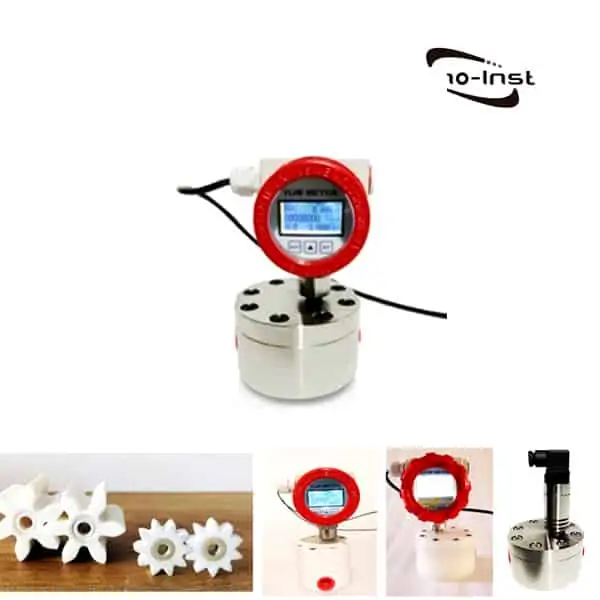
The Gear flow meter is a micro digital positive displacement flow meter. Can measure very small flow rates and quantify small volumes of liquid. High and low-temperature resistance (-196℃-200℃).
The Gear flow meter for Microflow is made of stainless steel and is used for precise continuous or intermittent measurement of the flow or instantaneous flow of liquid. It is especially suitable for the flow measurement of heavy oil, polyvinyl alcohol, grease, and other high-viscosity media. It can measure the viscosity of Fluid up to 10000Pa.s.
Extended reading: liquid nitrogen level measurement
Nitrogen Gas flow meter
Cryogenic turbine flow meters and Gear flow meters are both used to measure cryogenic liquid nitrogen flow meters.
However, if you want to measure nitrogen, what flow meter should you use?
There are four mainstream measuring instruments:
- Thermal gas mass flow meter. Directly measure the mass flow of common gases, including nitrogen.
- Coriolis mass flowmeter. Directly measure the mass flow of gas and liquid. It can be used to measure nitrogen, which is more expensive.
- The vortex flowmeter directly measures the volume flow of gas and liquid. It is necessary to add temperature and pressure measuring sensors and totalizers to calculate the mass flow.
- Orifice flowmeter. The orifice is used as a throttling element and is equipped with a differential pressure transmitter to calculate the volume flow. To convert into a mass flow, temperature, pressure sensors and totalizers must also be added.
Compared with the above, the thermal gas mass flowmeter is recommended, which is moderately priced, simple to install and maintain, and accurate.
Further reading: Nitrogen(N2) Flow Meter Types
Extended reading: 5 matters to pay attention to when choosing threaded Vortex Nitrogen Gas Flow Meter
Other Featured Cryogenic Flow Measurement Solutions
Extended reading:
What is the K-factor in a flow meter?
Cryogenic Flow Meters|Liquid Nitrogen-Liquid Oxygen-LNG fluids
FAQ
What is nitrogen flow?
The volume unit of the measurement gas is NM3, the standard square.
Strictly speaking, it should be a volume unit, not a flow unit. Sometimes it means m3/h to be practical.
The volume flow rate of gas is measured in m3/h. Because the gas volume is related to temperature, pressure, and humidity, in order to facilitate comparison, the volume flow rate usually refers to the standard state (temperature is 20℃, pressure is 0.11MPa, relative humidity is 65%). The flow rate at this time is Nm3/h is the unit, “N” means the standard state.
Sometimes abbreviated as irregular h-1 liquid flow unit is different in different countries and regions.
Mass units commonly used internationally: milligrams, grams, kilograms, metric tons, ounces, pounds, and shale;
Volume units: milliliters, liters, cubic millimeters, cubic centimeters, cubic meters, cubic inches, cubic feet, gallons (English), gallons (US), pints (English), dry pints (US), liquid pints (US), fluid ounce (US), fluid ounce (English), barrel, etc.
The nitrogen flow unit is Nm³/h, commonly known as cubic per hour. The preceding N indicates that when there is pressure, the general flowmeter is marked like this.
Hope it helps you!
How does a liquid flow meter work?
The liquid flow meter can be divided into the following categories according to the measurement principle:
Mechanics principles: instruments that fall into this category include differential pressure type and rotor type using Bernoulli’s theorem; impulse type and movable tube type using momentum theorem; direct mass type using Newton’s second law; using fluid momentum principle Target type; turbine type using the angular momentum theorem; vortex type and vortex type using the principle of fluid oscillation; pitot tube type using total static pressure difference, volume type, weir, trough type, etc.
Electrical principle: The instruments used for this kind of principle include electromagnetic, differential capacitive, inductive, strain resistance, etc.
Acoustic principle: There is an ultrasonic method for flow measurement using the acoustic principle. Acoustic (shock wave) etc. Thermal principle: There are calorimetric, direct calorimetry, indirect calorimetry, etc. that use the thermal principle to measure flow. Optical principle: laser type, photoelectric type, etc. are instruments of this type of principle. Principles of atomic physics: nuclear magnetic resonance, nuclear radiation, etc. are instruments that belong to this type of principle. Other principles: There are marking principles (tracing principles, nuclear magnetic resonance principles), related principles, etc.
More about: Liquid Flow Meters Guide
What is a totalizer in a flow meter?
Most of the flow meters have the function of cumulative flow calculation. The component that realizes this function is the totalizer of the flowmeter. If the flowmeter itself does not have a cumulative flow calculation function. Then, we can configure a separate flow totalizer for flow accumulation calculation.
Extended reading: Turbine Insertion Flow Meter for Large Diameter Pipeline
You nay like:
- Flow Measurement Units-What Is GPM in Flow Meter?
- What Is a BTU Meter?
- Flow Rate and Pressure Relationship-How to Calculate?
- Water Flow Measurement for Pipes and Open Channels
- Industrial Helium Flow Meters
- 6″ Flow Meters List | 6 Inch- DN150 Connection
- What Is Vortex Flow Meter? and FAQs
- Guide to Pulse Flow Meters: Must Know Before Shopping!
- What Is Turbine Flow Meter? and FAQs
- What Is a Thermal Mass Flow Meter?
Sino-Inst, Manufacturer for Liquid Nitrogen Flow Meters. A wide variety of liquid nitrogen flowmeter options are available to you.
Sino-Inst’s Liquid Nitrogen Flow Meters, made in China, Having good Quality, With better price. Our flow measurement instruments are widely used in China, India, Pakistan, US, and other countries.

Wu Peng, born in 1980, is a highly respected and accomplished male engineer with extensive experience in the field of automation. With over 20 years of industry experience, Wu has made significant contributions to both academia and engineering projects.
Throughout his career, Wu Peng has participated in numerous national and international engineering projects. Some of his most notable projects include the development of an intelligent control system for oil refineries, the design of a cutting-edge distributed control system for petrochemical plants, and the optimization of control algorithms for natural gas pipelines.
The Best Liquid Nitrogen Flow Meter&Liquid oxygen|Turbine type

Liquid nitrogen flow meter is a commonly used cryogenic flow meter. The low-temperature turbine flowmeter is a dedicated liquid nitrogen flowmeter. Please send an online inquiry!
Product SKU: Low temperature Turbine Flowmeter-The Best Liquid Nitrogen Flow Meter
Product Brand: Sino-Inst
Product Currency: USD
Product Price: 1500
Price Valid Until: 2039-09-30
Product In-Stock: InStock
5

